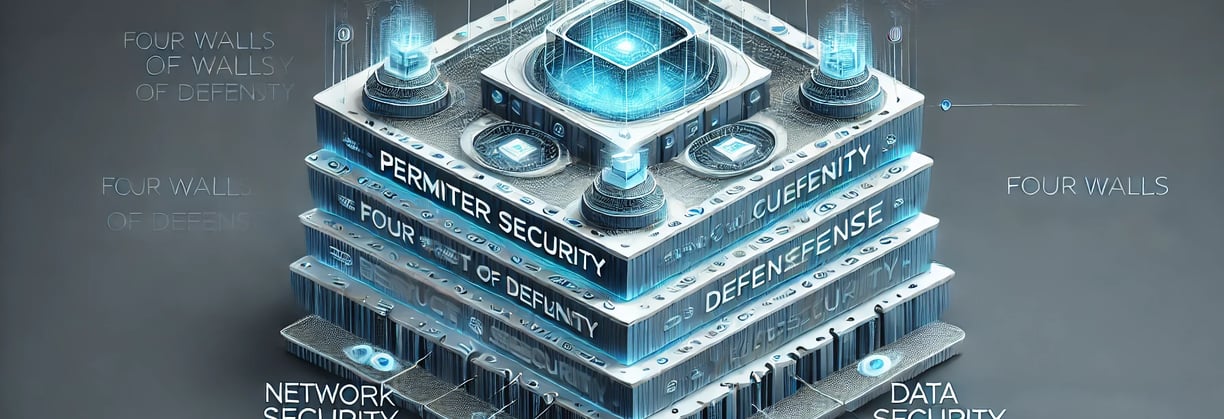The Four Walls of Defense in Cybersecurity: Build a Strong Security Framework
In today’s rapidly evolving digital world, cybersecurity is more crucial than ever. With cyber threats becoming more sophisticated, organizations and individuals need to establish a strong defense strategy to protect sensitive data and critical systems. One effective approach to building a comprehensive security plan is through the concept of the Four Walls of Defense in Cybersecurity. This framework offers a multi-layered defense strategy that ensures security at every level of an organization’s infrastructure. Let’s dive into what each wall entails and how together they form a resilient shield against cyberattacks.
CYBERSECURITY
1. Wall One: Perimeter Security
The first line of defense focuses on the perimeter—the outermost boundary of your network. Perimeter security protects the points where external users can access your system, including firewalls, intrusion detection/prevention systems (IDS/IPS), and secure gateways.
Firewalls: Act as gatekeepers by filtering incoming and outgoing traffic based on predefined security rules.
IDS/IPS: Monitor network traffic in real-time, identifying potential threats and preventing malicious activity.
Web Application Firewalls (WAF): Protect web applications by filtering and monitoring HTTP traffic between a web application and the Internet.
While perimeter security is essential, it is not enough to stop all attacks, as threats can come from inside the organization or bypass perimeter defenses.
2. Wall Two: Endpoint Security
As remote work and BYOD (Bring Your Device) policies become the norm, endpoint security is crucial. Endpoints—laptops, mobile devices, and servers—are often the entry points for cyber threats like malware, phishing, and ransomware.
Antivirus/Antimalware: Detects and neutralizes malicious software on devices.
Endpoint Detection and Response (EDR): Provides continuous monitoring and response capabilities for endpoint devices, quickly identifying breaches or vulnerabilities.
Patch Management: Regularly updating software and firmware to patch known vulnerabilities and prevent exploits.
Protecting the endpoints ensures that individual devices are less susceptible to attacks, even when the perimeter security is bypassed.
3. Wall Three: Network Security
Network security focuses on protecting the internal network infrastructure from both external and internal threats. The goal is to secure communications, control data flows, and segment the network to limit damage if a breach occurs.
Network Segmentation: Divides the network into different segments or zones to restrict access. This minimizes the lateral movement of threats within the network.
Virtual Private Network (VPN): Encrypts data in transit, ensuring secure access for remote users.
Zero Trust Architecture: Operates on the principle of "never trust, always verify," assuming that every user and device is a potential threat until proven otherwise.
Network security ensures that once attackers breach the outer layers, they cannot freely move across the system, reducing the impact of an attack.
4. Wall Four: Data Security
At the core of any cybersecurity strategy is data security. This final wall focuses on protecting the data itself—both at rest and in transit—regardless of where it resides in the infrastructure.
Encryption: Protects sensitive data by encoding it so that only authorized parties can access or decipher it.
Data Loss Prevention (DLP): Prevents unauthorized transfer of sensitive data outside the organization by monitoring and controlling access points.
Backup and Recovery: Ensures that data is regularly backed up and can be restored in case of a breach or ransomware attack.
Data security measures ensure that even if all other defenses fail, sensitive information remains protected, preventing major losses in case of a cyberattack.
Conclusion
The Four Walls of Defense in cybersecurity—Perimeter Security, Endpoint Security, Network Security, and Data Security—provide a holistic approach to protecting an organization’s digital assets. By fortifying each layer with the right tools and practices, organizations can significantly reduce the risks posed by cyberattacks.
However, no security strategy is foolproof. It is essential to continuously assess, monitor, and update defenses to stay ahead of emerging threats. With a strong defense framework in place, businesses can build trust with stakeholders, protect critical information, and maintain a resilient security posture in the face of an ever-changing threat landscape.


